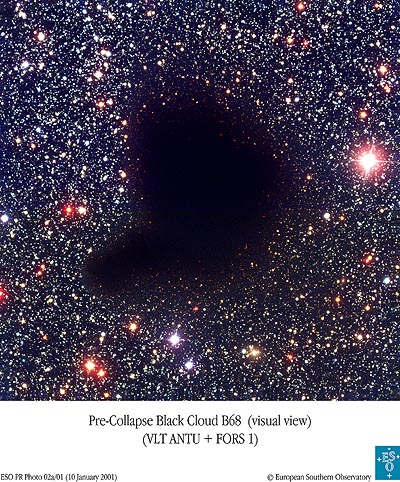







| BOOKS | F. A. Q. | ARTICLES | TALKS | ABOUT KEN | DONATE | BEYOND OUR KEN |
|---|

Image by Joćo Alves (European Southern Observatory), Charles Lada (Harvard-Smithsonian Center for Astrophysics), and Elizabeth Lada (University of Florida), using the European Southern Observatory's Very Large Telescope in Chile.
Text by Ken Croswell
Published in Astronomy (December 2003, page 50).
Stars are hot and bright, yet they can owe their existence to the cold and dark--frigid black clouds of gas and dust that float through interstellar space. The perfect example resides in southern Ophiuchus, east of Antares, where a black cloud named Barnard 68 blocks the light of thousands of stars that throng the Milky Way's central bulge.
Barnard 68 lies 300 to 400 light-years from Earth, so close that not a single foreground star mars its exquisite blackness. It measures 5 light-months across, corresponding to a radius 12,000 times greater than the Earth-Sun distance. Place the solar system at its center and it would engulf all the planets as well as the inner part of the Oort cloud of comets. It also would doom optical astronomy, blacking out every visible object beyond the solar system.
Cataloged by American astronomer Edward Emerson Barnard in 1919, the cloud is now classified as a Bok globule. In 1947, Harvard astronomers Bart Bok and Edith Reilly suggested that such a globule could collapse and form a star. Their idea later fell out of favor, but during the 1980s and 1990s, observations at infrared wavelengths--which penetrate the dust--confirmed that many Bok globules actually do nurse newborn stars.
Barnard 68, though, is still starless, giving astronomers the chance to study the first stage of star birth. The cloud has roughly the same mass as the Sun and consists mostly of two transparent gases--molecular hydrogen and atomic helium. But dust grains composed of heavier elements pepper the gas, darkening the cloud. And Barnard 68 is dark. Shoot a trillion photons of yellow light through its center and just one would reach the other side. If the Sun shone at its edge, an observer at the opposite edge would need a powerful telescope to see it as a dim star of 25th magnitude.
The cloud is as cold as it is dark: the temperature throughout is a mere 10 Kelvin above absolute zero, or -440° Fahrenheit, 40° F. colder than Pluto. It's so cold that most of the carbon monoxide and nitrogen gases have frozen onto the cloud's dust grains. The extreme cold is vital to the black cloud's starry future. To create a star, the cloud must collapse. However, the cloud's own heat threatens the collapse by exerting an outward pressure that counteracts gravity's inward pull. Because there isn't much heat, though, there isn't much outward pressure. If the collapse occurs, gravity will heat the infalling material, making it glow. (In the same way, gravity causes water to fall over a dam and generate energy.)
At January's meeting of the American Astronomical Society in Seattle, Charles Lada of the Harvard-Smithsonian Center for Astrophysics reported that Doppler shifts show the cloud's central parts to be moving inward while its outer layers are moving outward. This behavior suggests to him that Barnard 68 is vibrating--or, in his words, "jiggling like Jell-O"--once every 250,000 years. If so, it's the first Bok globule found to quiver. Or perhaps the cloud's collapse has already begun.
Barnard 68's fate is unclear. It may give birth to a new star, or it may dissipate into space. If all goes well, however, the cloud's gravity, perhaps augmented by the shock of a nearby supernova explosion, will cause the gas and dust to cascade toward the cloud's center. And from the cold shall come warmth, and from the dark shall come light, as another new star takes its place in the Milky Way.
Ken Croswell is an astronomer in Berkeley, California, and the author of Magnificent Universe and Magnificent Mars. He thanks the late Sir Fred Hoyle for supplying this article's title in his 1957 novel The Black Cloud.
"Elegant and eloquent"--Washington Post. See all reviews of Magnificent Universe here.
Ballesteros-Paredes, Javier, Klessen, Ralf S., and Vįzquez-Semadeni, Enrique, 2003. Dynamic Cores in Hydrostatic Disguise. Astrophysical Journal, 592, 188.
Barnard, E. E., 1919. On the Dark Markings of the Sky With a Catalogue of 182 Such Objects. Astrophysical Journal, 49, 1.
Bergin, Edwin A., Alves, Joćo, Huard, Tracy, and Lada, Charles J., 2002. N2H+ and C18O Depletion in a Cold Dark Cloud. Astrophysical Journal Letters, 570, L101.
Bergin, Edwin A., and Snell, Ronald L., 2002. Sensitive Limits on the Water Abundance in Cold Low-Mass Molecular Cores. Astrophysical Journal Letters, 581, L105.
Bianchi, S., Goncalves, J., Albrecht, M., Caselli, P., Chini, R., Galli, D., and Walmsley, M., 2003. Dust Emissivity in the Submm/mm. SCUBA and SIMBA Observations of Barnard 68. Astronomy and Astrophysics, 399, L43.
Bok, Bart J., and Reilly, Edith F., 1947. Small Dark Nebulae. Astrophysical Journal, 105, 255.
Hotzel, S., Harju, J., and Juvela, M., 2002. The Kinetic Temperature of Barnard 68. Astronomy and Astrophysics, 395, L5.
Hotzel, S., Harju, J., Juvela, M., Mattila, K., and Haikala, L. K., 2002. C18O Abundance in the Nearby Globule Barnard 68. Astronomy and Astrophysics, 391, 275.
Lada, Charles J., Bergin, Edwin A., Alves, Joao F., and Huard, Tracy L., 2003. The Dynamical State of Barnard 68: a Thermally Supported, Pulsating Dark Cloud. Astrophysical Journal, 586, 286.
Lai, Shih-Ping, Velusamy, T., Langer, W. D., and Kuiper, T. B. H., 2003. The Physical and Chemical Status of Pre-Protostellar Core B68. Astronomical Journal, 126, 311.
| BOOKS | F. A. Q. | ARTICLES | TALKS | ABOUT KEN | DONATE | BEYOND OUR KEN |
|---|